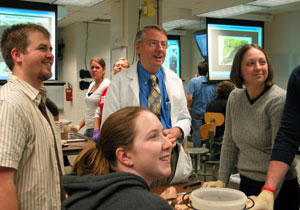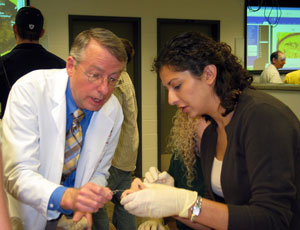 |
Paul Larsen, M.D., works with students during a recent class. Dr. Larsen recently received the University of Nebraska’s Outstanding Teaching and Instructional Creativity Award. |
Dr. Larsen is both, serving as a mentor who teaches foremost by example.
The UNMC physician educator has received the University of Nebraska’s Outstanding Teaching and Instructional Creativity Award (OTICA) for his excellence and creativity in teaching.
It’s an award that also reflects Dr. Larsen’s vast reach into medical teaching. UNMC’s professor of pediatrics and neurological sciences, as well as division chief for pediatric neurology, teaches students and physicians around the world via the Internet.
Leaning back in his chair, Dr. Larsen chuckles remembering how his son was sitting in his cognitive neuroscience class at Brigham Young University when he heard a familiar voice.
There, on the screen was “Dad,” who several years ago developed a Web-based neuroscience tutorial that has become the gold standard for neurological examination Web sites. The site, NeuroLogic, is used worldwide — including that day at Brigham Young University — as a resource for neurology.
“Showing what’s going on is so much better than telling,” Dr. Larsen said. “If a picture is worth a 1,000 words, then a movie is worth 10,000.”
|
|
A related site, PediNeuroLogic, features more than 150 video clips that show health care practitioners and students how a pediatric neurological exam should be done for infants and children.
Dr. Larsen’s interest in medicine evolved after his mother died of a brain tumor when he was 11. His interest in neuroanatomy and the neurosciences grew at the University of Utah, where he earned his medical degree in 1978. It was there, after his first son was born, that he became interested in working with children and decided to combine that with his love of the nervous system and neurology.
“How the brain works is really the incredible frontier of medicine,” he said. “The brain is where we live, think, feel and process information. In some ways, the rest of the body is a support system for the brain.”
Dr. Larsen eyes sparkle as he speaks about neuroanatomy, capturing the interviewer’s imagination and curiosity — as he would with a classroom of medical students.
“Teaching is a constant exercise in creating environments that invite attention, enthusiasm, exploration and learner confidence,” he said. “A student’s sense of adventure to learn how the brain works can be an incredible motivator in their studies.”
However, the heart of teaching, he said, combines a love of what you teach with a love for those you teach.
“No one cares how much you know until they know how much you care,” he said.
“I have reviewed many of the student and resident evaluations of Dr. Larsen’s teaching and three terms continually apply: outstanding teacher, dedicated physician and a great role model,” said his nominator, Bruce Buehler, M.D., chairman of the department of pediatrics and director of UNMC’s Munroe-Meyer Institute.
Following medical school, Dr. Larsen became a resident at the University of Arizona for two years and then returned to Utah where he was a fellow in neurology and pediatric neurology until 1983.
His first faculty position in pediatric neurology was at the University of Texas Health Science Center at San Antonio and then the Texas A&M University College of Medicine/Scott and White Clinic in Temple, Texas.
In 1990, the Salt Lake City native was recruited to Omaha as associate professor and division chief of pediatric neurology for UNMC, Creighton University and Children’s Hospital, with his primary appointment at Creighton. In 1998, he changed his primary appointment to UNMC when he became professor of pediatrics and neurological sciences.
Dr. Larsen — who recently completed a third Web-based tutorial on the lumbar puncture procedure and cerebral spinal fluid analysis — knows students are more motivated when they understand how the information presented helps solve a problem.
Whether through lectures, analogies, Web-based video, drawings or historical facts, Dr. Larsen focuses on specific teaching goals and how best to meet them. At times, that involves students diagramming the information.
 |
Besides the OTICA, Dr. Larsen has received numerous awards for his teaching, including five Golden Apples. |
At times, he invites actual patients into the classroom to help students understand various neurological conditions. The availability of the Web-based video cases, as well as other cases Dr. Larsen has videotaped, allow students to learn from actual patients.
“We have incredible tools to look at the brain, but these do not replace the clinical art and science of history taking and the neurological examination,” he said. “These video-taped examples are an extension of what occurs in the patient examining room between a patient and physician.”
During his career, Dr. Larsen has won numerous teaching awards. He received the Outstanding Pediatric Faculty Award for 1992 and 1994 from the Joint Creighton-UNMC Pediatric Residency Program. In 1997, he received the freshman class Golden Apple Award, Excellence in Teaching at Creighton University School of Medicine. That same year, Dr. Larsen was presented the Dedicated Teacher Award at Creighton. Since 1998, Dr. Larsen has received 5 Golden Apple Awards at UNMC including the Hirschmann Golden Apple Award, as well as the University of Nebraska College of Medicine Outstanding Teacher Award for 2000. He was named to Best Doctors in America 2003-2003 and 2005-2006.
To maintain students’ interest, Dr. Larsen sprinkles his teaching with facts and trivia, including his legendary “brain history breaks,” in which he challenges students with a history of medicine question. “Who was Thomas Willis?” he asks after discussing the “circle of Willis,” a ring of arteries that supply blood to the brain.
“Medicine is history and stories,” Dr. Larsen said. “Those stories include the stories of our patients, as well as the stories of the men and women of medicine. There’s a very rich history and heritage in medicine and understanding that history is an important part of our learned profession.”